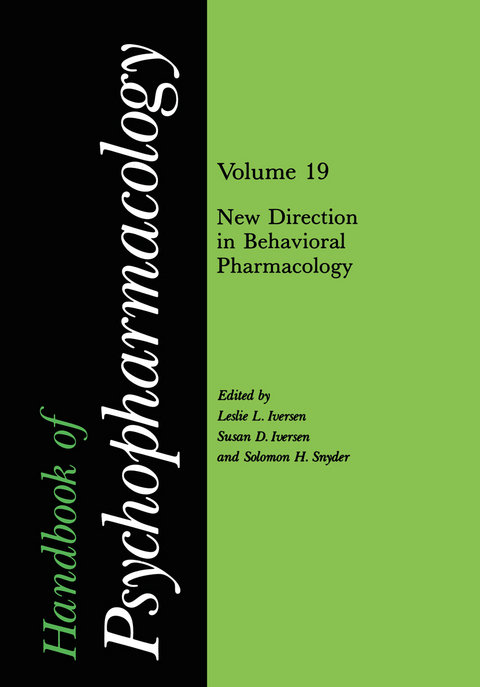
Handbook of Psychopharmacology
Springer-Verlag New York Inc.
978-1-4612-9017-9 (ISBN)
1 Conditioned Drug Effects.- 1. Introduction.- 2. Conditioned Drug Effects: Evidence and Explanations.- 3. Implications.- 4. References.- 2 Developmental Neuropharmacology: Clinical and Neurochemical Perspectives on the Regulation of Attention, Learning, and Movement.- 1. Clinical Phenomena and Research Design.- 2. Attention Deficit Disorder with Hyperactivity.- 3. Learning Disorders.- 4. Tourette’s Syndrome of Chronic, Multiple Tics.- 5. Overview.- 6. References.- 3 Structure, Process, and Mechanism: Case Studies in the Psychopharmacology of Feeding.- 1. Introduction.- 2. Control of Feeding: A First Look.- 3. Drugs and Food Intake.- 4. Interpretation of Pharmacological Action.- 5. Contextual and Temporal Dimensions of Behavior.- 6. Structure, Process, and Mechanism.- 7. Methodological Developments.- 8. Case Studies in the Pharmacological Analysis of Feeding.- 9. Control of Feeding: A Second Look.- 10. References.- 4 The Psychopharmacology of Aggression.- 1. Recent History of Psychopharmacological Aggression Research.- 2. Framework for the Behavioral Analysis of Aggression.- 3. Preclinical and Clinical Aggression Research.- 4. References.- 5 The Electrophysiological and Biochemical Pharmacology of the Mesolimbic and Mesocortical Dopamine Neurons.- 1. Introduction.- 2. Anatomy of Midbrain Dopamine Systems.- 3. Distinguishing between A9 and A10 Dopamine Systems.- 4. Identification and Characterization.- 5. Dopamine Neuron Function Regulation.- 6. Effects of Neurotransmitters on A10 Dopamine Neuron Activity.- 7. Summary.- 8. References.- 6 Psychopharmacology of Repeated Seizures: Possible Relevance to the Mechanism of Action of Electroconvulsive Therapy.- 1. Introduction.- 2. Functional Changes after Seizures.- 3. Biochemical Consequences of Seizures.- 4. NeuroendocrineMarkers of Neurotransmitter Changes Following Electroconvulsive Shock.- 5. Are Any Biochemical and Functional Changes Associated?.- 6. Can Biochemical or Behavioral Changes Be Associated with Antidepressant Action of Electroconvulsive Shock?.- 7. References.- 7 Psychopharmacology of Nicotine: Stimulus Effects and Receptor Mechanisms.- 1. Introduction.- 2. Nicotine as a Positive Reinforcer.- 3. Nicotine as an Aversive Stimulus.- 4. Discriminative Stimulus of Nicotine.- 5. Nicotine and Brain Mechanisms of Reward.- 6. General Conclusions.- 7. References.- 8 The Behavioral Effects of Opiates.- 1. Introduction.- 2. The Effects of Opiates on Pain.- 3. The Effects of Opiates on Reward.- 4. The Effects of Opiates on Cardiovascular Function.- 5. Other Effects of Opiates on Behavior.- 6. References.- 9 Neuropeptides and Memory.- 1. Neuropeptides.- 2. Conceptual and Methodological Considerations.- 3. Hypophyseal Peptides and Memory.- 4. Nonhypophyseal Peptides and Memory.- 5. Synthesis.- 6. References.- 10 The Actions of Neuroleptic Drugs on Appetitive Instrumental Behaviors.- 1. Introduction.- 2. Hypotheses on the Behavioral Actions of Neuroleptics.- 3. Evaluation of Experiments on Dopaminergic Involvement in Reinforcement.- 4. Incentive Explanation of Neuroleptic Actions.- 5. An Alternative Explanation of Dopamine Antagonist Effects on Operant Behavior.- 6. References.- 11 Second-Generation Antidepressants.- 1. Introduction.- 2. General Properties of Second-Generation Antidepressants.- 3. Methodological Approaches.- 4. Summary and Conclusions.- 5. References.
| Erscheint lt. Verlag | 12.11.2011 |
|---|---|
| Zusatzinfo | 37 Illustrations, black and white; XVI, 642 p. 37 illus. |
| Verlagsort | New York, NY |
| Sprache | englisch |
| Maße | 178 x 254 mm |
| Themenwelt | Medizin / Pharmazie ► Medizinische Fachgebiete ► Neurologie |
| Medizin / Pharmazie ► Medizinische Fachgebiete ► Pharmakologie / Pharmakotherapie | |
| Medizin / Pharmazie ► Medizinische Fachgebiete ► Psychiatrie / Psychotherapie | |
| Medizin / Pharmazie ► Pharmazie | |
| ISBN-10 | 1-4612-9017-1 / 1461290171 |
| ISBN-13 | 978-1-4612-9017-9 / 9781461290179 |
| Zustand | Neuware |
| Haben Sie eine Frage zum Produkt? |
aus dem Bereich


